The WD Blue SSHD is a new hybrid drive in a 2.5” form factor. Being a hybrid drive it strives for the best of both worlds. The HDD aspect gives it the high capacity of 1TB, with the performance that falls closer in line to an SSD, with claims of speeds to and from the host of 100MB/s it doesn’t quite reach SSD performance. The WD Blue SSHD has a SATA interface and is compatible with both PC and Mac.
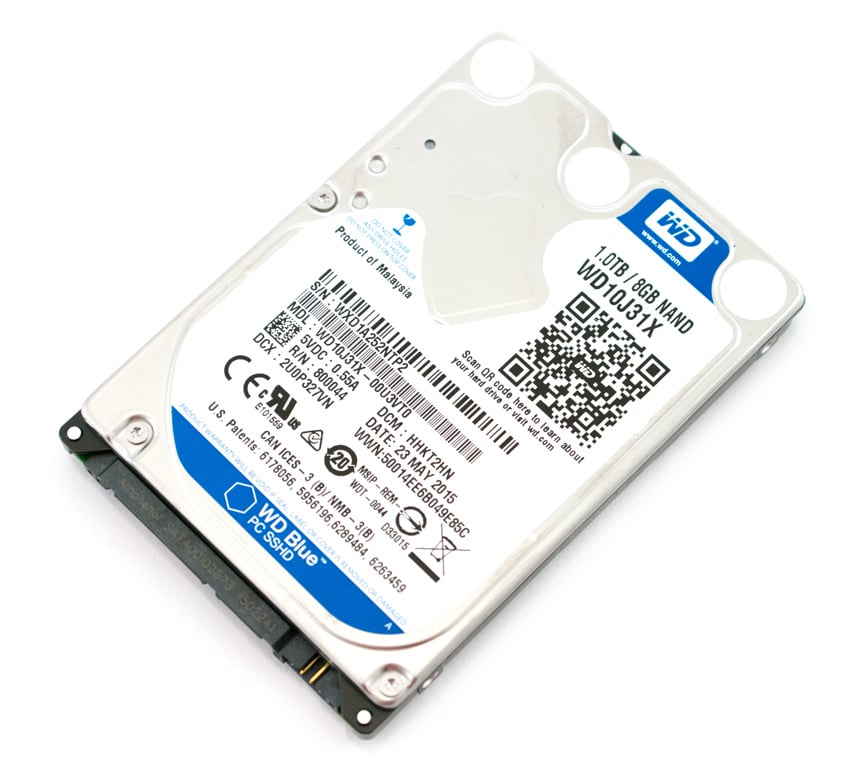
Power users, such as photographers, digital artists, and gamers, have to make sacrifices when it comes to selecting a drive. They can get high performance for a high price and limited capacity through an SSD or they can opt for a high capacity at a lower price with limited performance in an HDD. WD Blue SSHD positions itself in the middle. With 8GB of NAND flash, the WD SSHD Blue is several times faster than a traditional 5,400RPM HDD. The drive is self-learning, using an advanced set of algorithms to essentially tier more frequently used data to the flash side and the less frequently used data to the disk side. The SSHD has a traditional SATA interface meaning there are no special upgrades required to install the drive in most computers.
WD has released two form factors, a 3.5” 4TB for desktops, and this drive, which is 2.5” 1TB for laptops. With more and more power users opting to switch to laptops instead of desktops, this particular drive is more appealing to them. It gives them more capacity than generally comes with a laptop and gives them better performance than choosing an HDD only.
The WD Blue SSHD 1TB comes with a 3-year warranty and have a street price of $99.
WD Blue SSHD Specifications:
- Model number: WD10J31X
- Interface: SATA 6 GB/s
- Capacities: 1TB
- Form factor: 2.5-inch
- Advanced Format (AF)
- RoHS compliant
- Performance:
- Data transfer rate (max)
- Buffer to host: 6 GB/s
- Host to/from drive (sustained): 100 MB/s
- NAND Type: MLC
- NAND Size (GB): 8
- Cache (MB): 64
- Load/unload cycles: 600,000
- Non-recoverable read errors per bits read: <1 in 10⌃14
- Spinup (Max) 5VDC ±10% (A, peak): 1.3
- Spinup (Max) (W): 6.5
- Average power requirements (W)
- Read/Write: 1.65
- Idle: 0.65
- Standby and Sleep: 0.225
- Temperature (°C, on the base casting)
- Operating: 0 to 60
- Non-operating: -40 to 70
- Shock (Gs)
- Operating (2ms, read/write): 400
- Non-operating (2ms): 1000
- Acoustics (dBA)
- Idle: 24
- Seek (average): 25
- Limited warranty (years): 3
Design and build
The WD Blue SSHD is a hybrid drive with a form factor of 2.5” with a 9.5mm z-height. This size allows it to fit in almost all mounting conditions with space concerns and matches the size of other 1TB models on the market. WD follows their standard design scheme with a single sticker on the top cover giving users information such as model, capacity, data of manufacturer and other details.
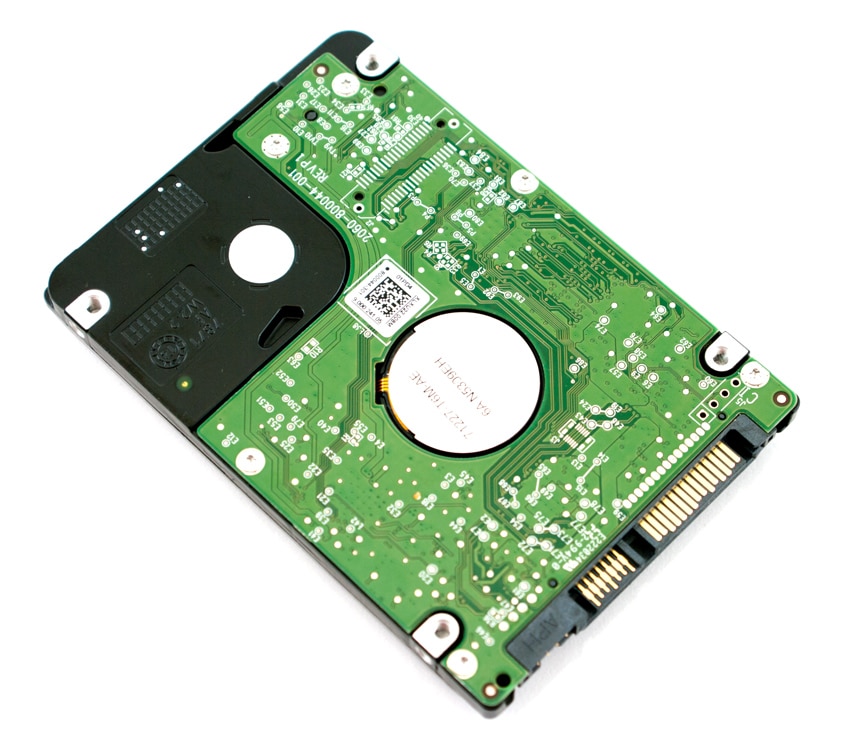
The bottom of the drive is mostly taken up by the circuit board and one can see the standard SATA interface.
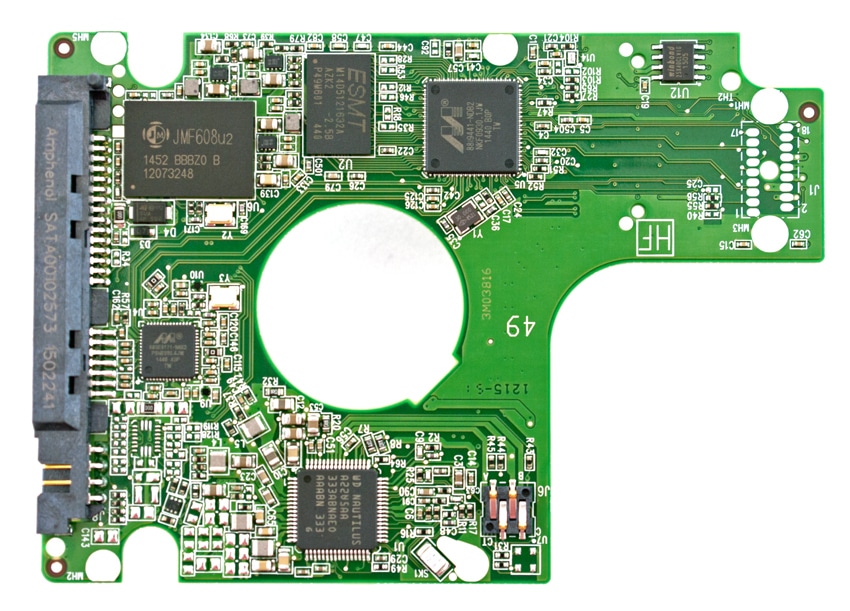
Inside the drive we see that it has Marvell HDD controller as well as a JMicron controller for the caching featureset.
Consumer Synthetic Benchmarks
All consumer SSD benchmarks are conducted with the StorageReview HP Z620 Workstation. We compared WD Blue SSHD with the following comparable:
Seagate Momentus XT SSHD 750GB
All IOMeter figures are represented as binary figures for MB/s speeds.
In our first test, which measures 2MB sequential performance, the WD Blue SSHD gave us speeds of 103.42MB/s read and 101.03MB/s write. The Seagate SSHD we tested did come out on top but just ever so slightly with 104.9MB/s read and 103.67MB/s write.
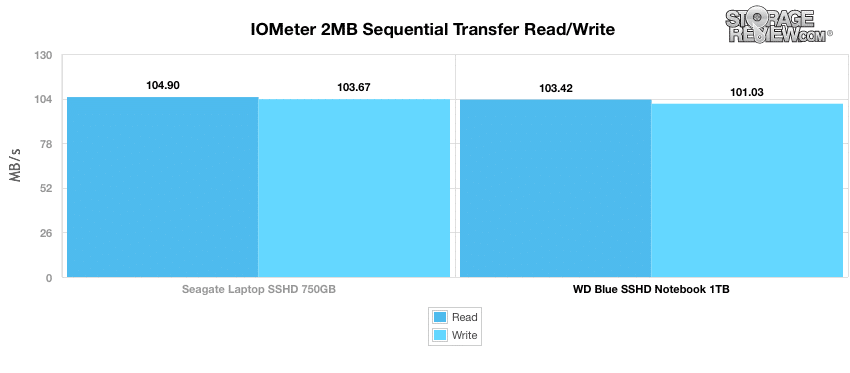
Our next test looks at 2MB random transfer performance. In this scenario, the WD Blue SSHD gave us speeds of 45.3MB/s read and 50.6MB/s write. This time the Seagate SSHD pulled a little more ahead with 50.67MB/s read and 54.71MB/s write.
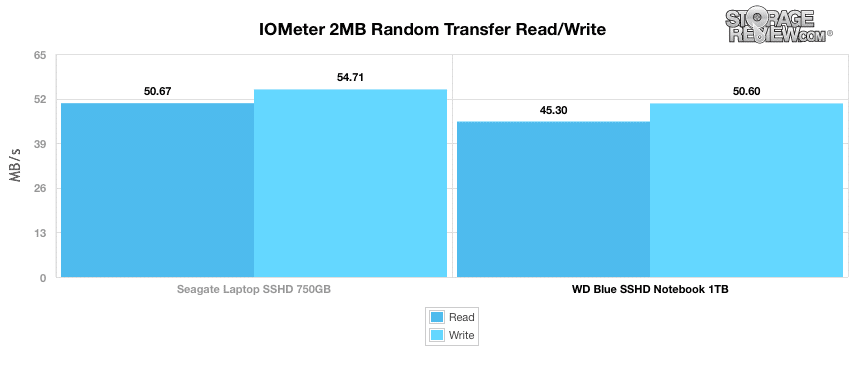
Switching to smaller 4K random transfers we see the WD Blue SSHD pull out on top, giving us speeds of 0.235MB/s read and 0.63MB/s write and the Seagate giving us 0.24MB/s read and 0.543MB/s write.
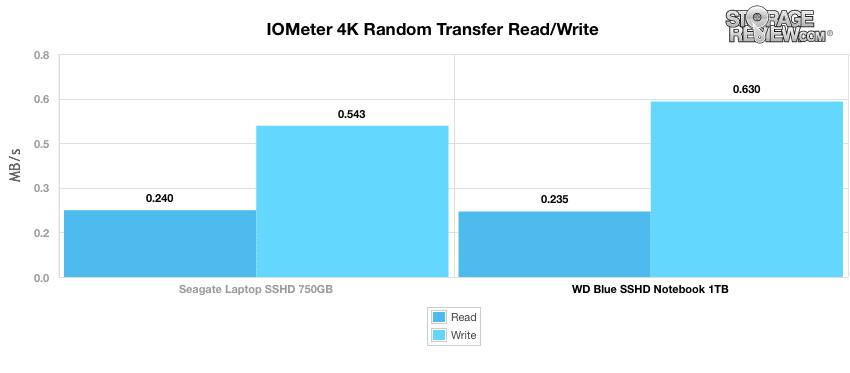
When looking at IOPS, the WD Blue SSHD had the best throughput on write with 161.23 IOPS (to Seagate’s SSHD with 138.96 IOPS) but came in second on read throughput with 60.18 IOPS, Seagate SSHD barely nudged it out with 61.34 IOPS.
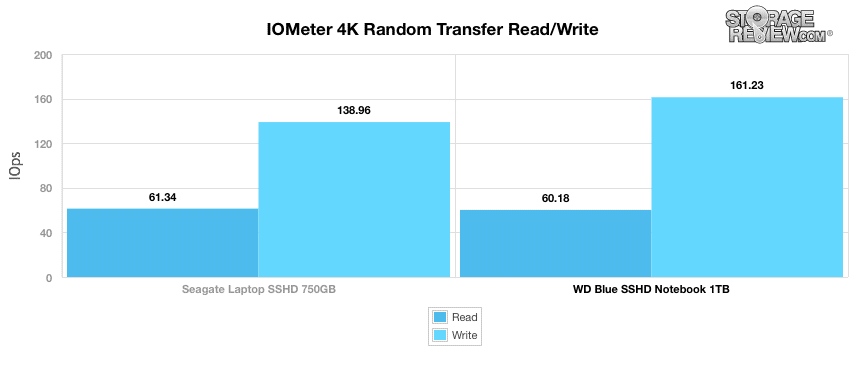
Moving to our 4K write latency benchmark, which looks at both the average and maximum readings, the WD Blue SSHD had an average latency of 6.2ms and a max latency of 1690.06ms. Where as the Seagate SSHD had a average latency of 7.2ms and a max latency of 1080.99ms. The WD performed better on average latency while the Seagate performed much better on max latency.
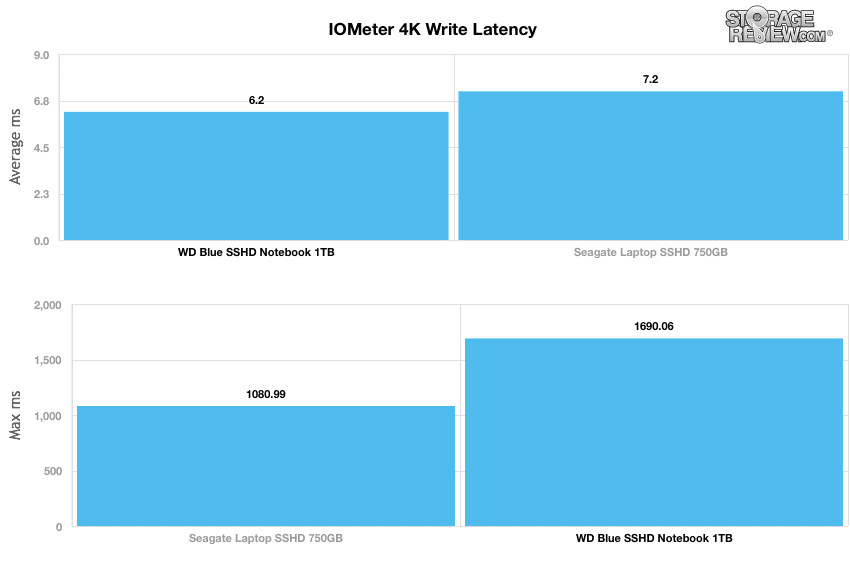
Our last series of synthetic benchmarks compare the hard drives in a series of server mixed-workloads with a queue depth of ranging from 1 to 128. Each of our server profile tests has a strong preference towards read activity, ranging from 67% read with our database profile to 100% read in our web server profile.
The first is our database profile, which uses a 67% read and 33% write workload mix primarily centered on 8K transfer sizes. In the scenario, the WD Blue SSHD started off behind the Seagate SSHD and trailed the entire test, peaking at 109.73 IOPS.
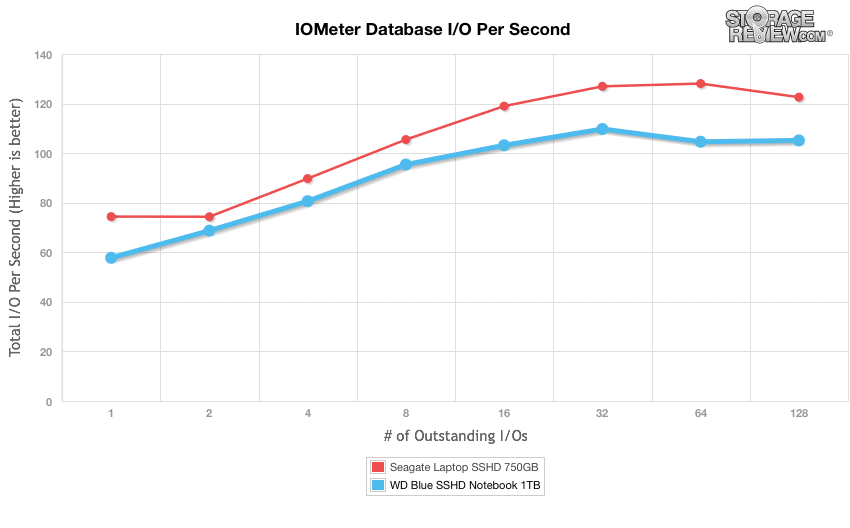
Our web server profile is read-only with a spread of transfer sizes from 512-byte to 512KB. Here, the WD Blue SSHD started off stronger and kept the lead for a little more than half way before it was edged out by the Seagate SSHD. However they finished within 3 IOPS of each other.
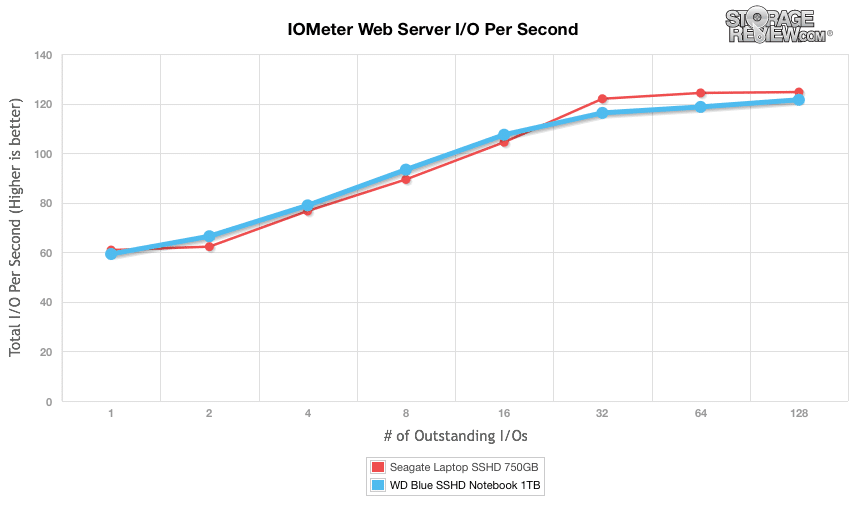
The next profile looks at a file server, with 80% read and 20% write workload spread out over multiple transfer sizes ranging from 512-byte to 64KB. In this scenario, the WD Blue SSHD delivered a range of 63.44 IOPS to 108.72 IOPS while the Seagate SSHD delivered a range of 65.62 IOPS to 124.24 IOPS.
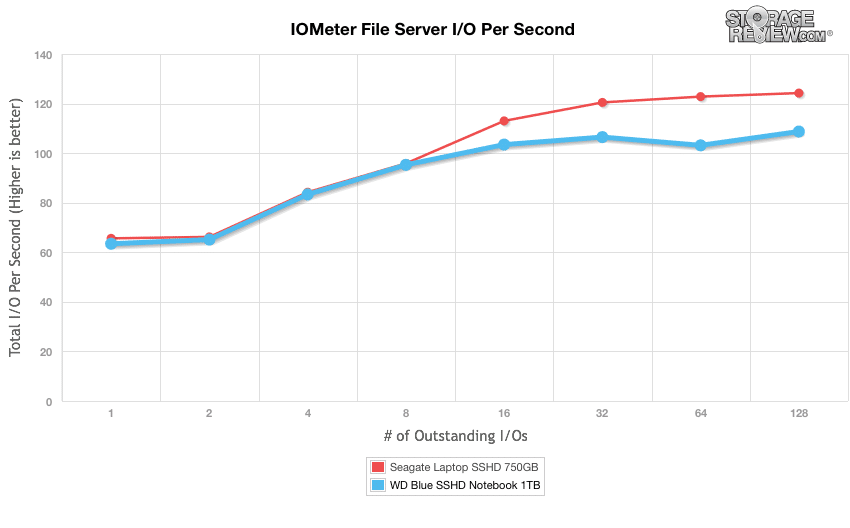
Our last profile looks at workstation activity, which is comprised of a 20% write and 80% read mixture using 8K transfers. As with our database profile, the WD Blue SSHD starts off behind and trails the Seagate SSHD throughout.
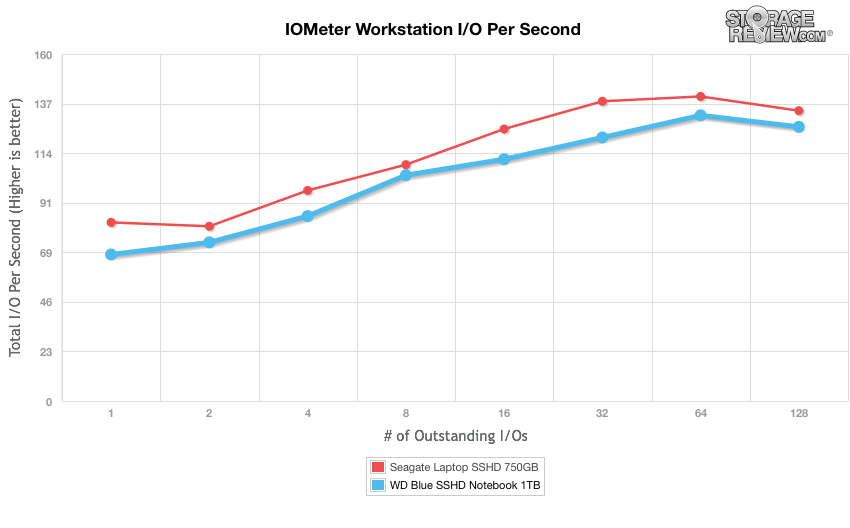
Consumer Real-World Benchmarks
For the average consumer, trying to translate random 4K write speeds into an everyday situation is pretty difficult. It helps when comparing drives in every setting possible, but it doesn’t exactly work out into faster everyday usage or better game loading times. For this reason we turned to our StorageMark 2010 traces, which include HTPC and Gaming traces to help readers find out how a drive might rank under these conditions.
The first real-life test is our HTPC scenario. In this test we include: playing one 720P HD movie in Media Player Classic, one 480P SD movie playing in VLC, three movies downloading simultaneously through iTunes, and one 1080i HDTV stream being recorded through Windows Media Center over a 15 minute period. Higher IOPS and MB/s rates with lower latency times are preferred. In this trace we recorded 2,986MB being written to the drive and 1,924MB being read.
In our HTPC profile, the WD Blue SSHD, for the first time in this review, pulls ahead of the Seagate SSHD by a wider margin. The WD Blue SSHD had speeds of 64.69MB/s, a throughput performance of 870 IOPS, and an average latency of 9.1ms. The Seagate SSHD on the other hand had speeds of 44.09MB/s, a throughput performance of 593 IOPS, and an average latency of 13.4ms.
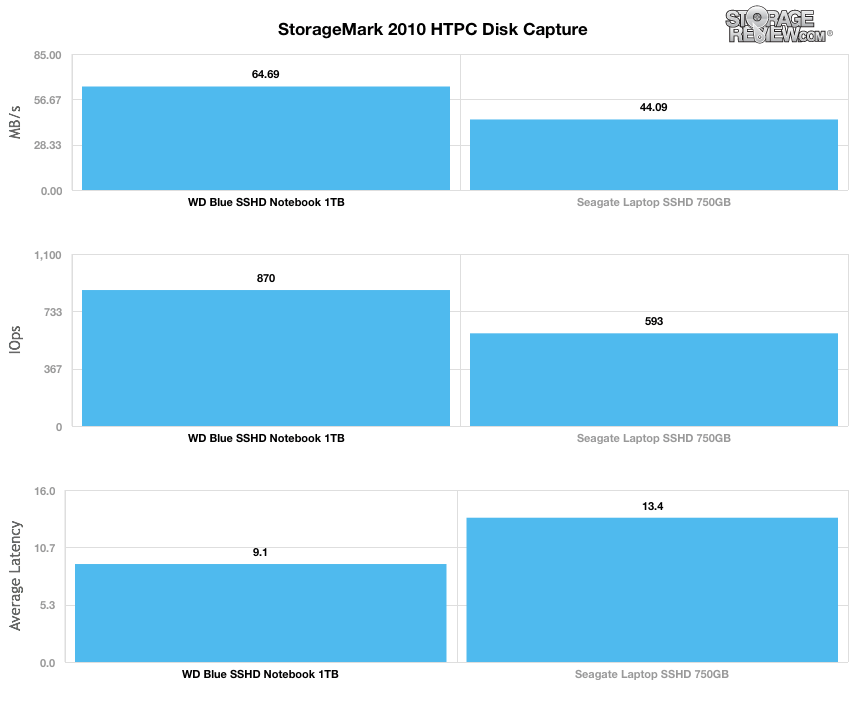
Our second real-life test covers disk activity in a gaming environment. Unlike the HTPC or Productivity trace, this one relies heavily on the read performance of a drive. To give a simple breakdown of read/write percentages, the HTPC test is 64% write, 36% read, the Productivity test is 59% write and 41% read, while the gaming trace is 6% write and 94% read. The test consists of a Windows 7 Ultimate 64-bit system pre-configured with Steam, with Grand Theft Auto 4, Left 4 Dead 2, and Mass Effect 2 already downloaded and installed. The trace captures the heavy read activity of each game loading from the start, as well as textures as the game progresses. In this trace we recorded 426MB being written to the drive and 7,235MB being read.
In our read-intensive gaming trace, WD Blue SSHD performed ever so slightly better than the Seagate SSHD. The WD drive had speeds of 58.98MB/s, a throughput of 1,101 IOPS, and an average latency of 7.2ms while the Seagate had speeds of 58.89MB/s, a throughput of 1,098 IOPS, and an average latency of 7.3ms.
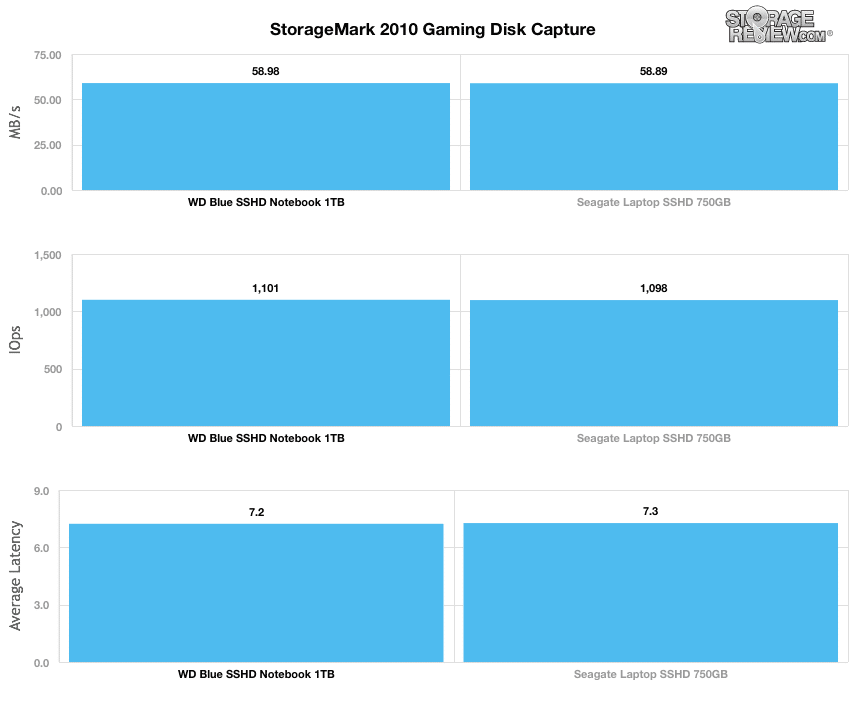
In our power efficiency tests, we measured the WD and Seagate SSHDs using 5-voltage (spin-up). Here, the idle consumption from the WD Blue SSHD measured 0.58W, where the Seagate was 1.07W. The startup for both drives was 4.07W for the WD and 4.82W for the Seagate. The WD had slightly higher power draws on read and writes, 4W and 3.96W respectively to Seagate’s 3.45W and 3.77W. And random reads gave us a power draw of 2.3W for the WD and 3.39W for the Seagate.
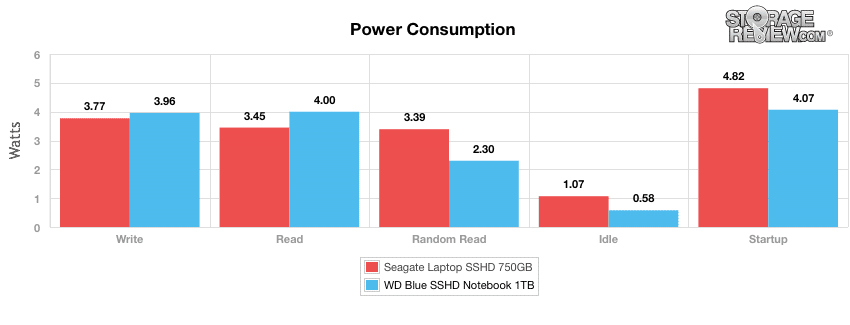
Conclusion
The WD SSHD Blue 1TB is a 2.5” hybrid drive that gives power users a marriage of HDD capacity with SSD performance. The drive has 8GB of NAND flash and is self-learning, moving the most accessed files to the flash and the least accessed are kept on the HDD. Users will see faster system boots, faster load times, and better responsiveness than they would see from a traditional HDD. The drive will fit in most laptops, is PC and Mac compatible, and comes with a standard SATA interface so there is no need for upgraded hardware in most cases.
Looking at performance, the two drives we compared performed very close to one another. Some tests, such as 2MB sequential and our gaming disk capture, showed barely any difference between the drives performance wise (though the WD Blue SSHD would have the advantage here have an extra 250GB of capacity). Neither drive performed as well as an SSD but both performed better than a non-hybrid HDD. In our 2MB sequential transfer benchmark the WD Blue SSHD had read speeds of 103.42MB/s and write speeds of 101.03MB/s. In 2MB random the drive had read speeds of 45.3MB/s and write speeds 50.6MB/s. In our 4K test the drive had a throughput of 60.18 IOPS read and 161.23 IOPS write and had an average write latency of 6.2ms. In our consumer real-world benchmarks the WD pulled ahead of the Seagate drive significantly in the HTPC scenario and ran neck and neck in the gaming scenario.
Pros
- Better performance than a Standard HDD
- 8GB NAND flash
- PC and Mac compatible
- Good performance in consumer real-world benchmarks
Cons
- Performance below an SSD
- Performed under the Seagate in mixed-workload synthetic benchmarks
The Bottom Line
The WD Blue SSHD 1TB is a 2.5” hybrid drive that is an ideal marriage of performance and capacity for power users that need such a mix in their laptops.




 Amazon
Amazon